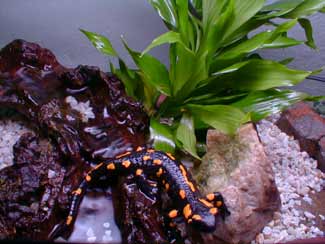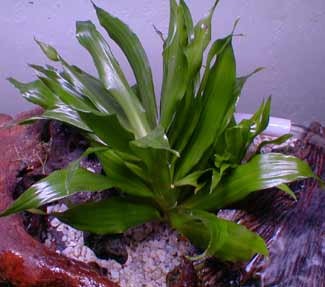
Green Dracaena;
aka, Dwarf Cane
About twenty-five or thirty years ago I bought one small tropical dwarf cane under the name Dracaena deremensis 'Janet Craig Compacta,' which is no longer regarded as the correct currant name, D. fragrans 'Compacta,' even though still often listed by the old synonym.
The plant was obtained for a salamander & frog vivarium. It flourished to the highest degree. Young starts or cuttings from the tips were transferred to other terrariums, until I was overwhelmed with the stuff! I tried putting some of the spares outside in the garden, but even before the weather turned cool in autumn, they dried up for needing higher humidity.
It likes to be in an unheated (room temperature) wet vivarium under artificial full-spectrum lighting in a medium of plain aquarium gravel, with lid for maximum humidity. The only fertilizer it ever gets is salamander & newt poop. Its finger-thick rootstock sends out long twiny roots to find nutrients throughout the gravel.
After all these years, I always have a ton of it. Just before taking these photos (in January 2004), I cleaned out the vivariums for the first time in three years, & threw onto the compost about a grocery bag's worth of this plant from just three tanks, then started the bog terrariums anew with choice fresh re-starts.
 Potted dracainas are shrubs that will slowly grow to be small trees, & in their native South African are fifteen feet tall. But 'Compacta' is a dwarf version which, when adapted to a pot, can potentially grow four to six feet, although frequently only a foot or two tall, & nicely suited to boggy terrarium.
Potted dracainas are shrubs that will slowly grow to be small trees, & in their native South African are fifteen feet tall. But 'Compacta' is a dwarf version which, when adapted to a pot, can potentially grow four to six feet, although frequently only a foot or two tall, & nicely suited to boggy terrarium.Even as a dwarf, in time they do outgrow a twenty-gallon vivarium, & periodically they must be cut short or re-started anew, for they will either push the lids up on the tanks, or its top will start growing sideways along the underside of the lid.
If the lower stalk becomes leafless, it is not so attractive as a terrarium plant, but the top of the plant can be cut off & stuck in wet gravel. It roots invariably. Or the whole plant can be cut flush to the ground & the main rhyzome will send up a replacement.
It makes a nice houseplant in a pot with normal watering & daily misting, but mine after going-on-three decades in maximum-humidity with their roots always under water, quickly wilt & die when I've tried to acclimate some of it as potted houseplants exposed to low indoors humidity. I've seen potted specmens that did fine at lower humidities, but mine is fully adapted to vivarium life only. Even in an outdoors "bog bowl" where the roots remained as wet as in the terrariums, the leaves suffered from want of humidity. But even if it had adapted outdoors for a while, it would've died come autumn chills, as it's definitely tropical.
The genus name means "Dragoness" & was first given to Dracaena draco which is a tree native of the Canary Islands. That large species exudes a red fluid called dragon's blood. There's nothing particularly dragon-like about D. deremensis. It can produce red flowers, but in twenty years mine have never flowered.
The photo at top shows the plant in the freshly cleaned & replanted fire salamander's terrarium, after having tossed all the bigger scruffier plants & saving a couple small ones only. I've had the European fire salamander for over fifteen years, but it's partner died at about age twelve. It's a very friendly little scamp who comes running to the front of the glass when I reach in, & takes worms or crickets from my fingers. The second photo shows a second fresh start in another terrarium.